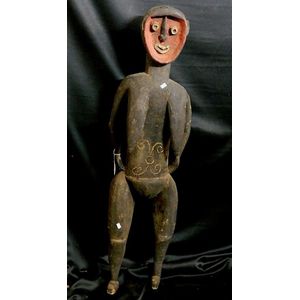19th Century French Marquetry Gueridon Table with Porcelain Inset
A 19th century French marquetry gueridon table with flower display cavity, of serpentine kidney shape, the top with lid inset with porcelain plaque, raised on four legs embellished with ormolu mounts, 53 x 38 x 85 cm
You must be a subscriber, and be logged in to view price and dealer details.
Subscribe Now to view actual auction price for this item
When you subscribe, you have the option of setting the currency in which to display prices to $Au, $US, $NZ or Stg.
This item has been sold, and the description, image and price are for reference purposes only.
- Gueridon - The French term originally the name for a small stand for a candelabrum, but now used to describe any small circular topped table or pedestal, often with an intermediate shelf and on three legs..
- Serpentine - Resembling a serpent, in the form of an elongated 'S'. A serpentine front is similar to a bow front, except that the curve is shallow at each end, swelling towards the middle. The term presumably derives from its similarity to a moving snake or serpent. Serpentine fronts are usually veneered, with the carcase either being cut and shaped from a solid piece of timber, or built in the 'brick' method.
- Marquetry - In marquetry inlay, contrasting woods, and other materials such as ivory, shell and metal are inlaid either as panels or in a single continuous sheet over the surface of the piece. The design may be straightforward, such as a shell pattern or a basket of flowers, or it may be infinitely complex, with swirling tendrils of leaves, flowers and foliage, such as one finds, for example, in the "seaweed" patterns on longcase clocks of the William and Mary and Queen Anne periods.
- Mounts - Mounts are used to describe bronze, brass and ormolu adornments on furniture especially quality furniture in the rococo and classical revival style, and are also the cabinet makers' name for the metal fittings on furniture, such as hinges, locks and handles, and metal edges and guards which protect furniture from damage.
- Ormolu - Ormolu was popular with French craftsmen in the 18th and 19th century for ornamental fittings for furniture, clocks and other decorative items. True ormolu is gilt bronze, that is bronze that has been coated with gold using a mercury amalgam. Due to the health risks associated with using mercury, this method of creating ormolu was discontinued in France in the 1830s. A substitute was developed consisting of about 75% copper and 25% zinc, however it was inferior to the bronze version. It was often lacquered to prevent it tarnishing.
This item has been included into following indexes:
Visually similar items

A Louis XV style foliate decorated composit over-mantel mirror. 164 cm x 110 cm
Sold by
in
for
You can display prices in $Au, $US, $NZ or Stg.

An ancestor sculpture, Nogwi, Papua New Guinea in female form 113 cm
Sold by
in
for
You can display prices in $Au, $US, $NZ or Stg.

A Horse Racing Roulette game, the Sandown
Sold by
in
for
You can display prices in $Au, $US, $NZ or Stg.

A circular silver giltwood marble top table, continental, 19/20th century, 79 high, 120 diameter
Sold by
in
for
You can display prices in $Au, $US, $NZ or Stg.
